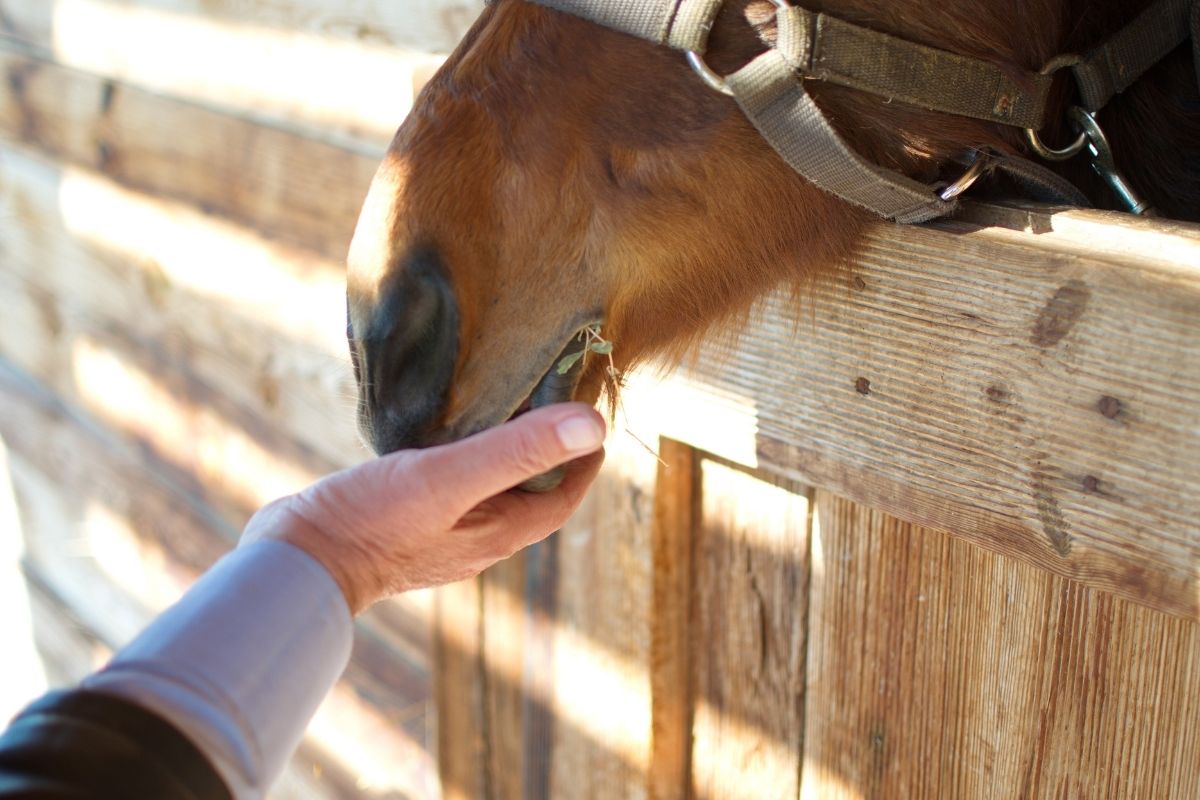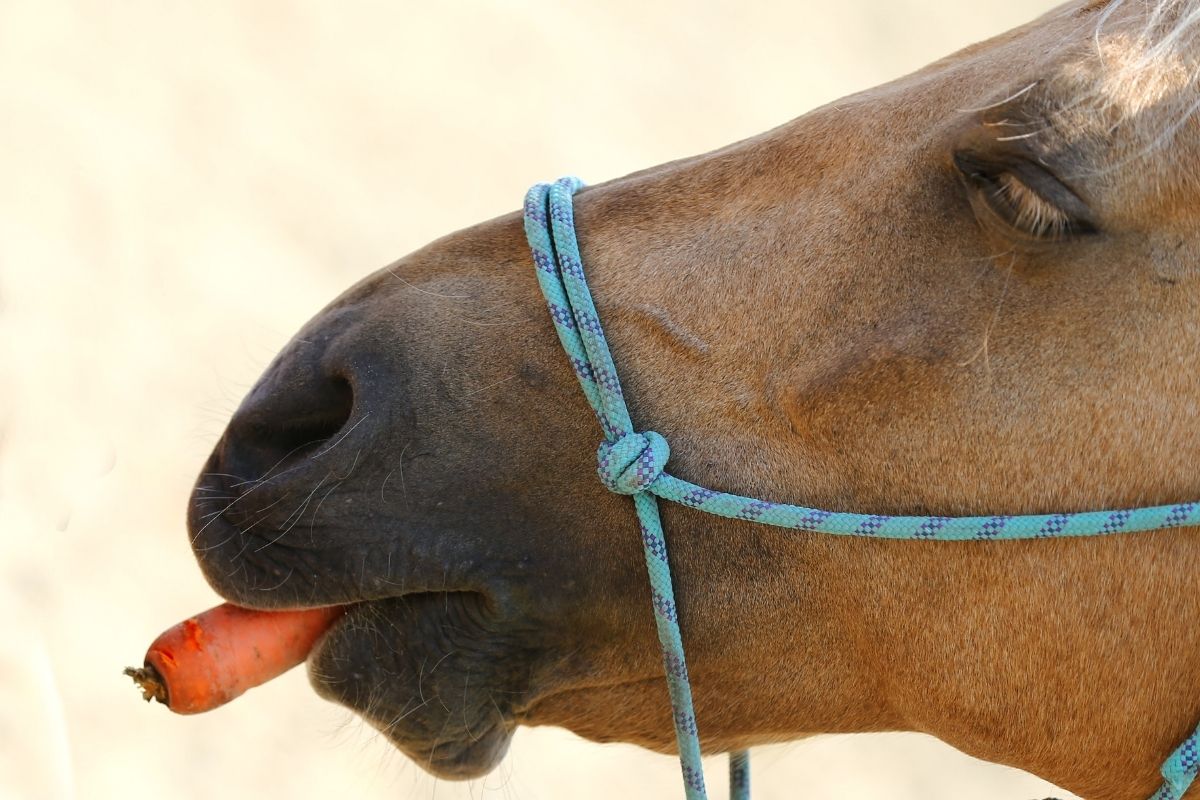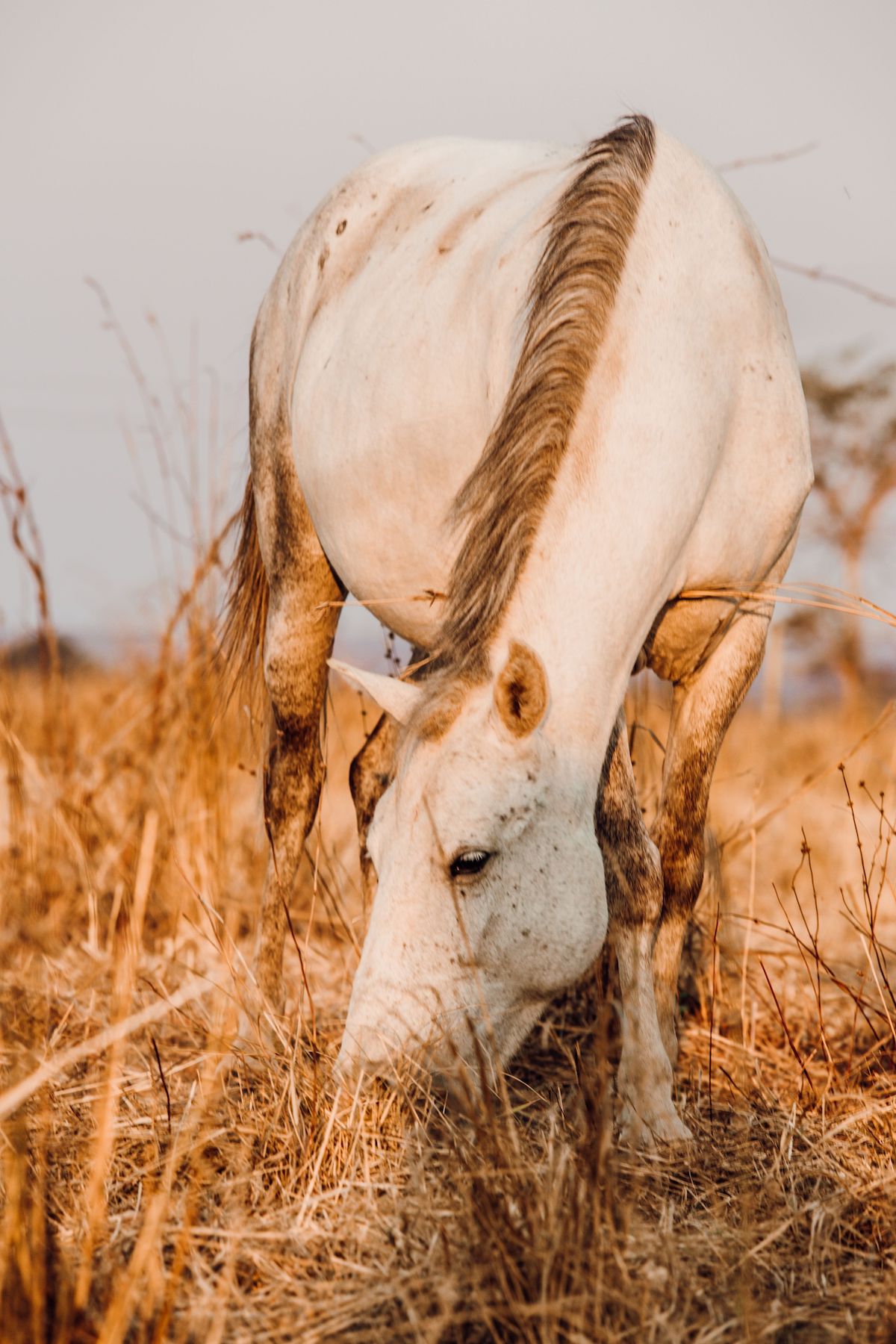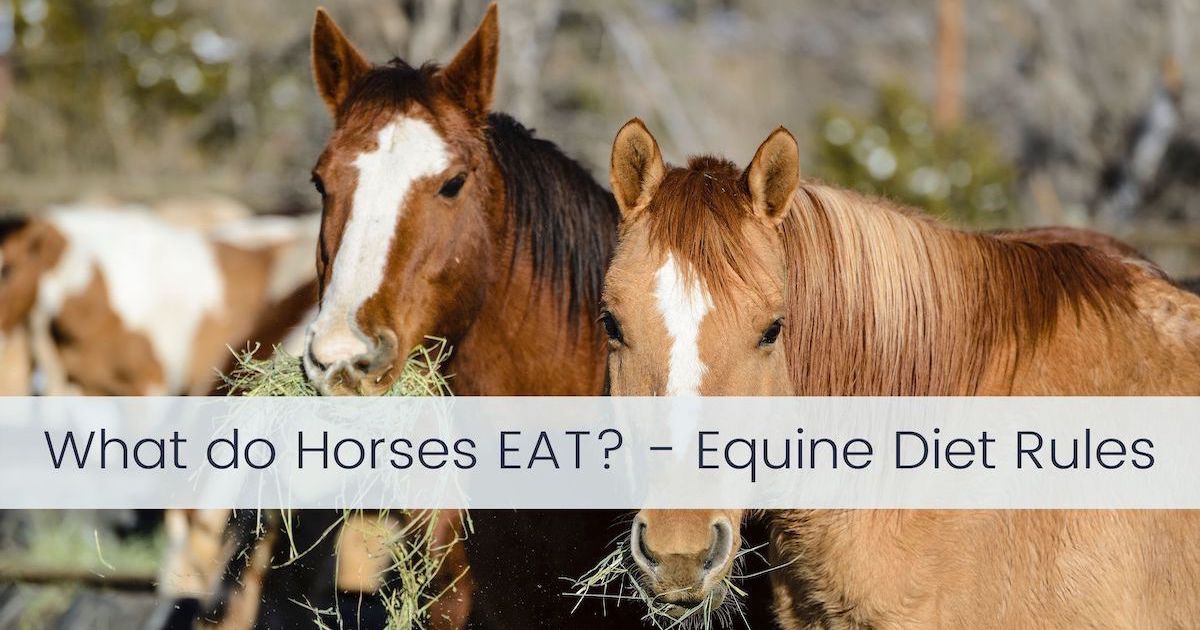What is the Best Feed for my Horse?
Horses have a unique digestive tract that is quite different from humans. With that knowledge, a common question is what do horses eat? There are rules to feeding horses. Remembering these rules will set you up for a good foundation for overall horse care.
A horse has a long digestive system that requires a high-fiber diet consumed over a long period of time. In fact, horses spend a majority of their day eating many small meals. Here are the basic rules for a rounded equine diet.
Our Top Suggestions for a Healthy Horse Diet Plan
Provide Plenty of Roughage
Your average horse will do very well on high-quality hay or pasture alone. Horses are designed to eat plenty of roughage. Their digestive systems are tailored to break down grassy stalks. A horse will typically eat one to two percent of its body weight in roughage daily.
During winter or drought, it is essential to supplement pasture grazing with hay. However, during spring, when the grass is lush, hay rations may not be necessary.
Horses that are stalled or don’t get much turnout will need access to hay 24/7. This allows them to mimic grazing in a pasture and keeps their digestive tracts full. If there isn’t enough pasture or hay, one can add grain to their diet.
Grain in Small Amounts
Some horses require grain to supplement their diet. This should be fed in small amounts, multiple times a day, rather than one large meal. Small frequent meals are more natural for the horse, allowing the horse to digest their food better.
Start with a minimal amount of grain and adjust as necessary for the horse and the amount of work it’s doing. Large meals of grain can cause problems with digestion and result in colic.
Gradually Change Feeds and Feeding Schedules
Sometimes changes need to be made to a horse’s feed or feeding schedule. This is due to the season or amount of work they are doing. Always make these changes incrementally. Sudden changes in a horse’s diet can lead to colic.
Ideally, change each meal over several weeks. For example, if changing feed types, replace 10% of the old feed with new every two days until 100% on the new feed.
Accurately Measure the Feed
Different types of hay or grain can weigh different amounts. Therefore, it’s essential to measure the right amount for your horse accurately.
An average 2000 pound horse will eat 15 to 20 pounds of roughage a day. A bale of hay contains multiple flakes, which can be pulled apart for feeding. The amount of hay in each flake can vary greatly depending on the size of the flake or the type of hay. Measuring the bale of hay can help determine how much of that bale your horse needs daily.
For grain, start by measuring your horse’s feed by weight using a kitchen or postal scale. Once you know how much a typical ration weighs, measure that amount using a feeding scoop. This is more convenient at feeding time.
Don’t Feed Around Exercise
Exercise and digestion are two things that should not occur together. Ideally, a horse should have one to three hours of digestion after a meal before exercise. This is dependent on what type of work is required.
A full digestive system limits a horse’s ability to work. Blood flow is also diverted away from the digestive organs. This slows gut movement and can lead to colic.
You should fully cool down a horse after work before giving them a meal.
Stick to a Routine
You should keep horses on a consistent feeding schedule for optimal digestion. They are creatures that thrive on routine. Unfortunately, for colic-prone horses, a change in feeding time can trigger an episode.
What do Horses Eat?
An average horse thrives on roughage as the main component of its diet. This is because high-quality pasture contains most of the nutrients a horse requires to be healthy.
However, depending on the season or location, good pastures can be hard to come by. Hay is the next best option for providing roughage. Therefore, it is important to source high-quality hay. In addition, hay testing can be used to ensure that any shortfalls in minerals and vitamins are supplemented.
Grains are an unnatural supplement for horses but can be used when necessary. Traditional grains include oats and corn. However, it can be easy to overfeed horses on grain, leading to ulcers, dental problems, and colic.
Concentrates are also used to supplement a horse’s diet—these help make up for shortfalls in nutrition and provide a quick source of energy. Concentrates are primarily used for mares in foal, nursing mares, performance, or working horses in addition to their regular diet.
Concentrates are a mixture of grains, flaxseed, beet pulp, molasses, vitamins, minerals, and other ingredients. Commercial mixes will have several different components. In addition, some feed mills can mix concentrates to your specifications.
Supplements such as salts and minerals can be included in a concentrate mix or offered separately. For example, a salt block or loose salt in a pasture allows horses to help themselves. Some salt may also come mixed with minerals.
Horses love to eat treats such as apples, carrots, sugar cubes, or other fruit and vegetables. However, too many treats can cause digestive issues as it is not a normal part of their diet. Too many treats can also cause weight gain, leading to problems such as Pituitary Pars Intermedia Dysfunction (PPID) or laminitis.
How Much Should Horses Eat?
An average adult horse should eat dry matter weighing two to three percent of its body weight. Dry matter is what remains in the feed after all the water is evaporated. At least half of a horse’s diet should be pasture or hay.
The amount of food a horse requires depends strongly on its level of activity and quality of food. For example, if a horse is worked or ridden more, it will require more food during the day, or it can become underweight.

How Do You Feed a Horse?
Horses should be fed small amounts often, and if possible, all day. This is easiest for horses that are turned out on pasture and have access to ample grass. If a horse is kept in a stable, it should have constant access to hay bales to mimic pasture feeding. If a horse requires grains in its diet, this should be fed in at least three small meals.
Horses like routine, so it is essential to try and feed them at the same time every day. Clean, fresh water is also vital. Ensuring that the troughs are also clean and mold-free is critical to their health.
What Do Wild Horses Eat?
Wild horses can graze on large areas of land. This allows them to eat grass, the seed heads of grasses, and other edible shrubs and plants. Wild horses typically stay close to fresh water sources.
Did you know a wild horse can graze for 15-17 hours a day?
Which Type of Feeds Shouldn’t My Horse Eat?
There are a variety of foods that can negatively affect your horse’s digestive system.
Fruit and Vegetable Treats
High amounts of fruit and vegetables such as apples and carrots can cause colic, obesity and lead to serious health problems. This includes endocrine disorders and painful laminitis.
Ensure your horse isn’t fed more than one or two wedges of fruit a day. If there are any fruit trees around, fence them off to prevent your horse from grazing nearby. Also, put up signs to dissuade members of the public from giving your horse treats.
Stone Fruits
Stone fruits can be very sweet and tasty to your horse. However, the pits can get stuck in the esophagus and cause your horse to choke.
Vegetables in the Cabbage Family
Turnips, cabbages, kale, and broccoli can all cause gas buildup in a horse’s digestive system, leading to colic.
Potatoes and Tomatoes
These members of the Nightshade family should not be fed to horses.
Chocolate or Other Sugary Foods
While your horse will significantly enjoy these, they can cause health problems like colic or obesity.
Bread and Cakes
These have the potential to cause blockages in a horse’s digestive tract.
Meat
Meat is unnecessary for horses as they are obligate herbivores. Meat fed over a long period of time can also cause digestive and bone problems.
Garden Waste
Garden waste poses a significant risk. They can include plants, weeds, and toxins from garden sprays which may be poisonous. Fresh grass clippings should be avoided as horses can eat it much faster than natural grazing and cause colic. Grass clippings could also have been treated with chemicals toxic to a horse.
Moldy or Dusty Hay
These should be avoided as they can damage a horse’s lungs. In addition, some horses are prone to asthma, and dusty hay can trigger episodes.
Brans
Brans, including wheat and rice bran, are not recommended as they can cause mineral imbalances.
Cattle Feed or Feed Formulated for Other Animals

Cattle feed often contains ionophores which are drugs helpful for ruminant animals. Unfortunately, ionophores, even in small amounts, can be highly toxic to horses.
Effective Horse Feeding Strategies
When it comes to feeding horses, always feed by weight, not volume. This applies to both hay and grain.
Hay
As mentioned, a bale of hay is divided into flakes. However, not all flakes are created equal, and each flake can vary in thickness. Start by calculating how much feed your horse needs per day. Then divide this by the number of feedings. This will determine how much to give at each meal.
Always feed hay first, as this will help slow down digestion. This makes digestion more effective for rich, calorie-dense grains first.
Grain
Most feed companies compile their feeding requirements based on weight. Measure on a scale how much grain is required per day, and then divide this into per feed. Use a scoop for easy measuring once you know how much grain is required.
Timing
Routine, routine, routine! Space out feedings and be consistent. Horses naturally feed in small, frequent meals, so it’s essential to try and mimic this feeding schedule. Never leave more than eight hours between a feed.
Changes
Make changes gradually. A horse’s digestive system is a host for all types of flora. These florae are delicate and can be detrimentally affected by sudden changes in feed. This principle applies to both hay and grain.

FAQs on Horse Feeding
Do horses need grass and hay?
Yes, and no. Horses require a majority of their diet to come from roughage. Therefore, while grassy pasture is preferred, high-quality hay will suffice if a limited amount or none is available.
What supplements should I feed my horse?
High-quality pasture will contain all the nutrients an average horse requires. However, if your horse requires extra nutrition, it may need supplemental feeding. This is common for mares in foal, nursing mares, or horses doing strenuous work. Supplements include grains and concentrates. Make sure to consult a nutritionist to find out what is best for your horse.
Do horses need minerals and vitamins?
If a horse is fed high-quality grass or hay, it shouldn’t need extra minerals and vitamins. However, if a feed is lacking in particular minerals or vitamins, it should be supplemented. Providing a salt block or mineral block can be helpful as it allows the horse to use it as it sees fit.
What are some horse feeding problems to look out for?
Major feeding problems include changing feeds too quickly, feeding too many treats, and having an improper feed ratio. If your horse is looking under or overweight, it is essential to consult a veterinarian for advice.
A major health problem for horses is colic. Classical signs of colic include: frequently looking at their side, lying down/rolling, little or no passing of feces, small fecal balls, poor eating behavior. If your horse shows any of these signs, call a veterinarian immediately.
How should I be watering my horse?
Water is an essential part of a horse’s diet. Fresh, clean water should always be provided. Horses eating pasture grass won’t drink as much as horses only on hay.
